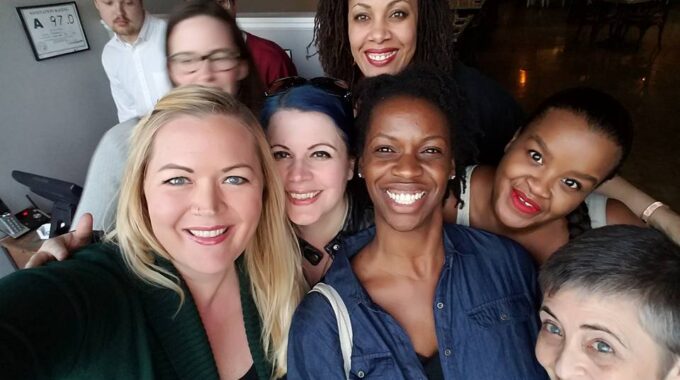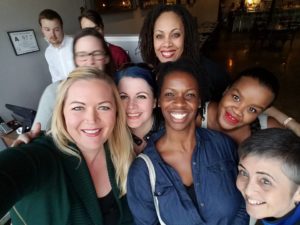This piece, Strategic Planning Through An Anti-Racist Lens, first appeared on the NeonCRM blog as…

Being Anti-Racist Requires Real Life Experiences

Being Anti-Racist Isn’t Just Learning Theories
*If we are genuinely interested in being anti-racist, it can’t just be about theory. We spend hours and hours talking about racism. We attend workshops and read books and articles about racism. But we don’t ever get beyond the theoretical. We still mostly socialize with all white people. Work in mostly all white places of employment. Shop and eat at mostly all white businesses. Our daily life experiences are still almost exclusively with white people.
The theoretical learning we do begins to teach us how to not cause harm to others. However, no matter how much reading we do or how many workshops we attend, we will never be able to learn about every possible conversation or experience we might have with a person of color. Having real relationships and experiences helps us develop the agility to navigate a variety of human interactions. Furthermore, the only way we truly internalize anti-oppressive ideas is to interact with people who are not like us. Real, caring, intimate, loving relationships with black people and brown people. With gay people and transgender people. With people who are immigrants and people who are differently abled. Otherwise, everything we are talking about is based on something we have read instead of something we care about at a deep, emotional level.
Accountability Is Key To Being Anti-Racist
When we interact with people over time, we develop relationships in which we get to know them. We learn how to interact with them in ways that make the relationship stronger. When we develop relationships with people of color, obviously, these same processes happen. But the additional layers related to race push us to use what we have learned into practice. And over time, we start to view the world differently and feel some accountability. This happens for two reasons. First, there’s nothing like real experience to expand our understanding. In driver’s education, we spend hours learning about driving a car. However, the first time I drove an actual car was a wholly different experience than simply reading about it. Being with a person of color makes that person real in ways no workshop ever could. It changes our understanding from theory to reality.
The second reason real life interactions with people of color matter is that as we form relationships, we start to care about actual people. If these people we love and care about are impacted directly by racism, we become invested in being anti-racist. It is unfortunately far too easy to rationalize and excuse racist behavior when we don’t know people being impacted by that behavior. But that all changes once we have actual relationships with people who are. Furthermore, these relationships help us break down the stereotypes we have been taught about people of color. We start to understand that people of color are not monolithic and that there is as much diversity among people of color as there is among white people. This is particularly true if we haven’t engaged in tokenizing, and have more than just one friend who is a person of color.
First Elephant In The Room-Do It Organically
There are 2 elephants in the room here that need mentioning. The first is that it is disingenuous to be on a mission to make friends with black people. Doing so is repetition of a pattern of white people using black people. The healthy way to diversify our community of friends is to stop doing things in all white spaces. Being in all white spaces isn’t aligned with how to live as an anti-racist. So it means we need to deepen our awareness of the spaces we are in and intentionally choose more integrated spaces. Over time, by consistently searching for and being in diverse spaces, we will naturally meet people who we genuinely like and are interested in getting to know. And we will slowly, and organically, diversify our community of friends.
Second Elephant In The Room-Do It With Integrity
The second elephant in the room is that, for people of color, interactions with white people are fraught with the danger of being harmed. As a white person, I don’t have a history of being harmed by people of color. But many people of color are harmed daily by white people, verbally, physically, or emotionally. This means we white people need to be cognizant of that history as we interact with people of color. If a person of color is slow to trust me or isn’t as warm to me as I would like, I need to think about that within the framework of what this person has very likely experienced with other white people.
Whenever a person of color is willing to enter into any sort of relationship with me, that person is demonstrating a resilience and strength that is worthy of my respect. I am not entitled to anything from this person. The boundaries set may make me feel uncomfortable. However, as a white person, it is easy for me to claim these boundaries are unreasonable because I may feel entitled to certain things from people of color. There are no easy answers here. But humility and a willingness to sit with our own discomfort are both key to navigating these relationships with integrity.
Are You Committed To Truly Being Anti-Racist?
My call to action for folks who are working on being anti-racist is to spend time thinking about the spaces you are in and the people with whom you spend time. Are they primarily white? If the answer is yes, perhaps it is time to do things differently. Specifically, how can we all do better to live more fully anti-racist lives instead of simply talking about being anti-racist?
I’d love to hear from folks about all of this in the comments. How have you tackled this? Or if you haven’t, what is holding you back?
*A Note For Readers
This piece is aimed specifically at people who identify as white. I want to be clear that many of the statements don’t apply in conversations about racism for people of color. However, the concepts can be translated for any identity that has power and/or privilege over any other identity.




Nice piece, Heidi – perfectly summarized regarding the elephant in the room. I am fortunate to have grown up, played with and lived next door to POC of color – it’s always seemed intuitive to have friends of all races, religions, and sexual leanings. Nevertheless, like all folks of white ilk, I have spent a lot of time in the past couple of years committed to hearing deeper, engaging with intention, and checking myself when buttons are pushed. It is not easy nor is it comfortable. I stumble daily but am intent on helping to change the framework that we have benefitted from.
Thanks, Liz. I wish I could say it was always intuitive for me to be with lots of different kinds of people. I think I knew it, but didn’t act on it by making choices that would cause that to happen. I can also say that I have witnessed you engage with intention and to sit with discomfort as you learn to do better. You inspire me regularly by your willingness to not be perfect, to engage anyway, and to integrate new ways of thinking and being as you do this. Truly grateful to know you and call you friend.
This is excellent- thank you and it comes at an amazing moment in time for me. I can’t wait spread this. I’m in lots of conversations at the moment but this is a practical guide that will be so helpful.
Thanks so much, Denise. I’m glad it is useful to you. I appreciate you commenting here. My life is so much richer knowing you.